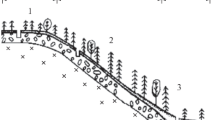Summary
Sporocarps and sclerotia were collected for a one-year period in 23- and 180-year-old Abies amabilis stands in western Washington. All sporocarps were classified and chemically analyzed for N, P, K, Ca, Mg, Na and Fe. Lactarius sp. and Cortinarius sp. contributed the largest proportion of the total annual epigeous sporocarp production in both stands. Annual epigeous production was 34 kg/ha in the young stand and 27 kg/ha in the mature stand. Hypogeous sporocarp production increased from 1 kg ha-1 yr-1 to 380 kg ha-1 yr-1 with increasing stand age. High sclerotia biomass occurred in the young (2,300 kg/ha) and mature (3,000 kg/ha) stands. Peak sclerotia and epigeous sporocarp biomass in the young stand and epigeous and hypogeous sporocarp biomass in the mature stand coincided with the fall peak of mycorrhizal root biomass.
In the young stand, sporocarps produced by decomposer fungi concentrated higher levels of Ca and Mn than those produced by mycorrhizal fungi. In the mature stand, sporocarps of decomposer fungi concentrated higher levels of N, P, Mn, Ca and Fe than sporocarps of mycorrhizal fungi. Epigeous and hypogeous sporocarps concentrated higher levels of N, P, and K than sclerotia or mycelium. The highest concentration of N (4.36%), P (0.76%), K (3.22%) and Na (1,678 ppm) occurred in epigeous sporocarps. Highest Mn (740 ppm) and Ca (20,600 ppm) concentrations occurred in mycelium, while highest Mg (1,929 ppm) concentrations were in hypogeous sporocarps and highest Fe (4,153 ppm) concentrations were in sclerotia.
Similar content being viewed by others
References
Björkman E (1949) The ecological significance of the ectotrophic mycorrhizal association in forest trees. Svensk Bot Tidskr 43:223–262
Burova LG (1975) Reserves of macromycetic fungi in forest biogeocenoses Moscow. Mikol Fitopatol 9:3–6
Edmonds RL (1979) Decomposition and nutrient release in Douglas-fir needle litter in relation to stand development. Can J For Res 9:132–140
Fogel R (1976) Ecological studies of hypogeous fungi. II. Sporocarp phenology in a western Oregon Douglas-fir stand. Can J Bot 54:1152–1162
Fogel R, Hunt G (1979) Fungal and arboreal biomass in a western Oregon Douglas-fir ecosystem: distribution patterns and turnover. Can J For Res 9:245–256
Hering TF (1966) The terricolous higher fungi of four Lake District woodlands. Trans Br Mycol Soc 49:369–383
Hinneri S (1975) Mineral elements of macrofungi in oak-rich forests on Lenholm Island, inner archipelago of S.W. Finland. Ann Bot Fenn 12:135–140
Lamb RJ (1979) Factors responsible for the distribution of mycorrhizal fungi of Pinus in eastern Australia. Aust For Res 9:25–34
Richardson MJ (1970) Studies on Russula emetica and other agarics in a Scots pine plantation. Trans Br Mycol Soc 55:217–229
Romell LG (1938) A trenching experiment in spruce forest and its bearing on problems of mycotrophy. Svenks Bot Tidskr 32:89–99
Thesleff A (1919) Studier over basidsvampfloran i sydostra Finland med hansyn till dess sammansattning, fysiognomi, fenologi och ekologi. Bidr. t. kanned. af Finl. natur o. folk 79:no. 1
Trappe JM (1962) Fungal associates of ectotrophic mycorrhizae. Bot Rev 28:538–606
Ugolini FC, Dawson H, Zachara J (1977) Direct evidence of particle migration in the soil solution of a podzol. Science 198:603–605
Vogt KA, Edmonds RL (1980) Patterns of nutrient concentration in basidiocarps in western Washington. Can J Bot 58:694–698
Vogt KA, Edmonds RL Grier CC, Piper SR (1980a) Seasonal changes in mycorrhizal and fibrous-textured root biomass in 23 and 180 year old Pacific silver fir stands in western Washington. Can J For Res 10:523–539
Vogt KA, Edmonds RL, Grier CC (1980b) Dynamics of ectomycorrhizae in Abies amabilis stands: The role of Cenococcum graniforme. Holarctic Ecology in press
Author information
Authors and Affiliations
Rights and permissions
About this article
Cite this article
Vogt, K.A., Edmonds, R.L. & Grier, C.C. Biomass and nutrient concentrations of sporocarps produced by mycorrhizal and decomposer fungi in Abies amabilis stands. Oecologia 50, 170–175 (1981). https://doi.org/10.1007/BF00348033
Received:
Issue Date:
DOI: https://doi.org/10.1007/BF00348033




